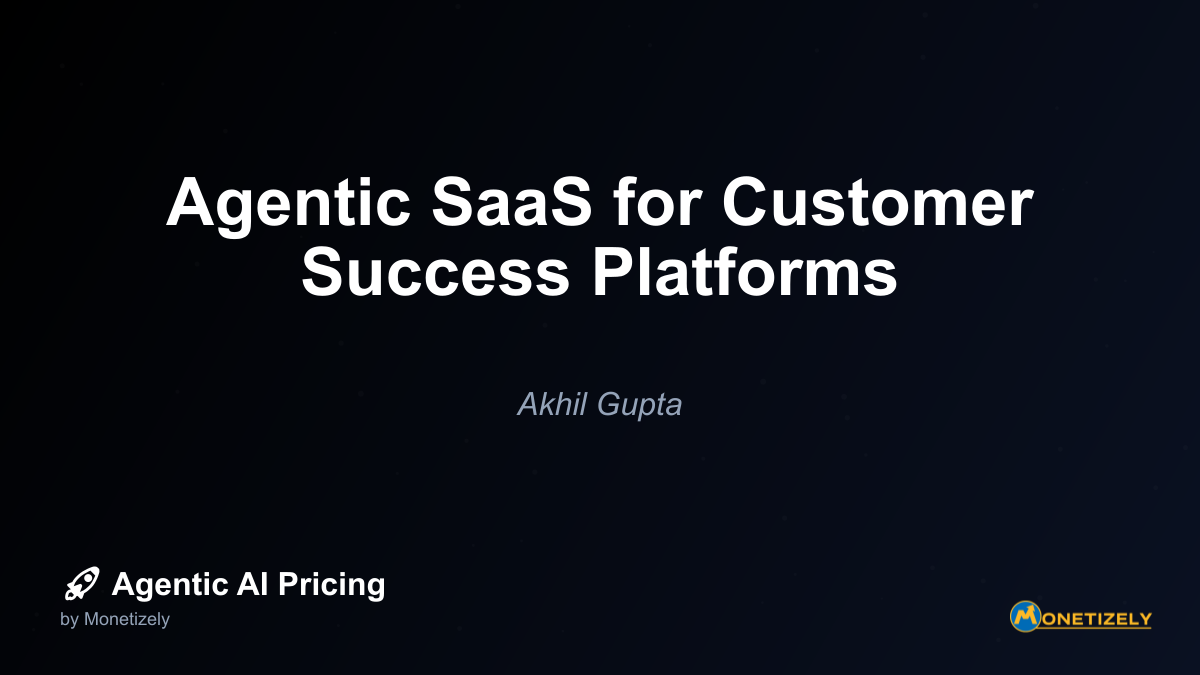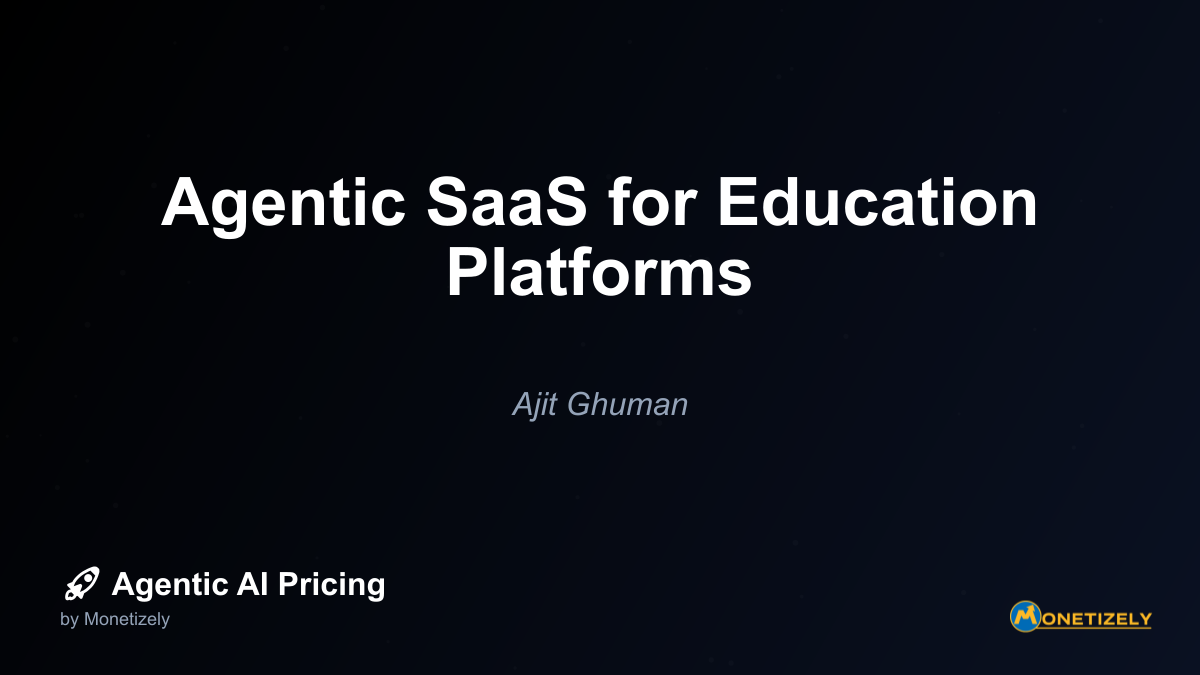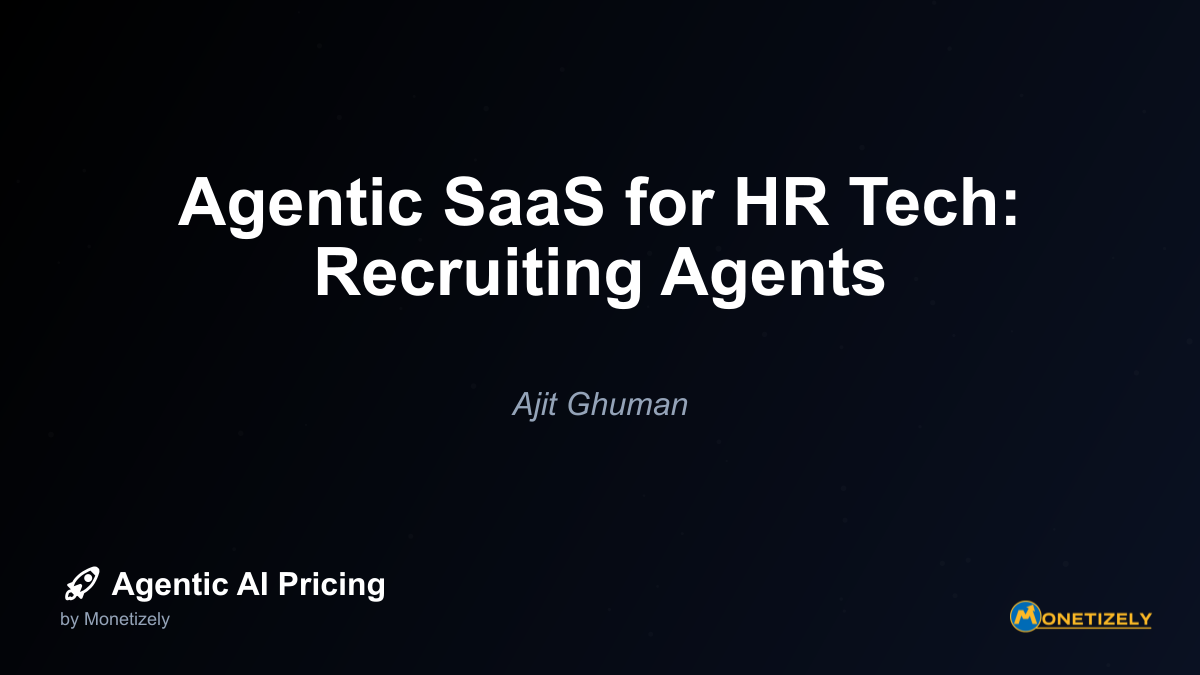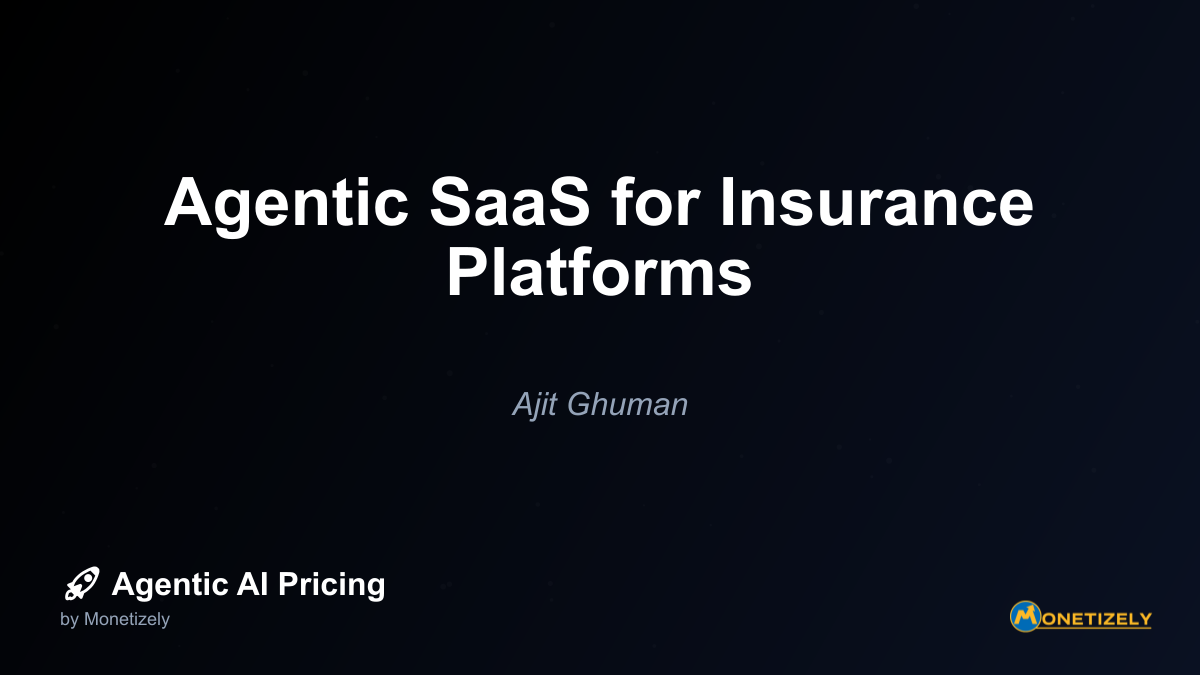· Akhil Gupta · Vertical Applications · 13 min read
Government SaaS with Agentic Functions
AI and SaaS Pricing Masterclass
Learn the art of strategic pricing directly from industry experts. Our comprehensive course provides frameworks and methodologies for optimizing your pricing strategy in the evolving AI landscape. Earn a professional certification that can be imported directly to your LinkedIn profile.
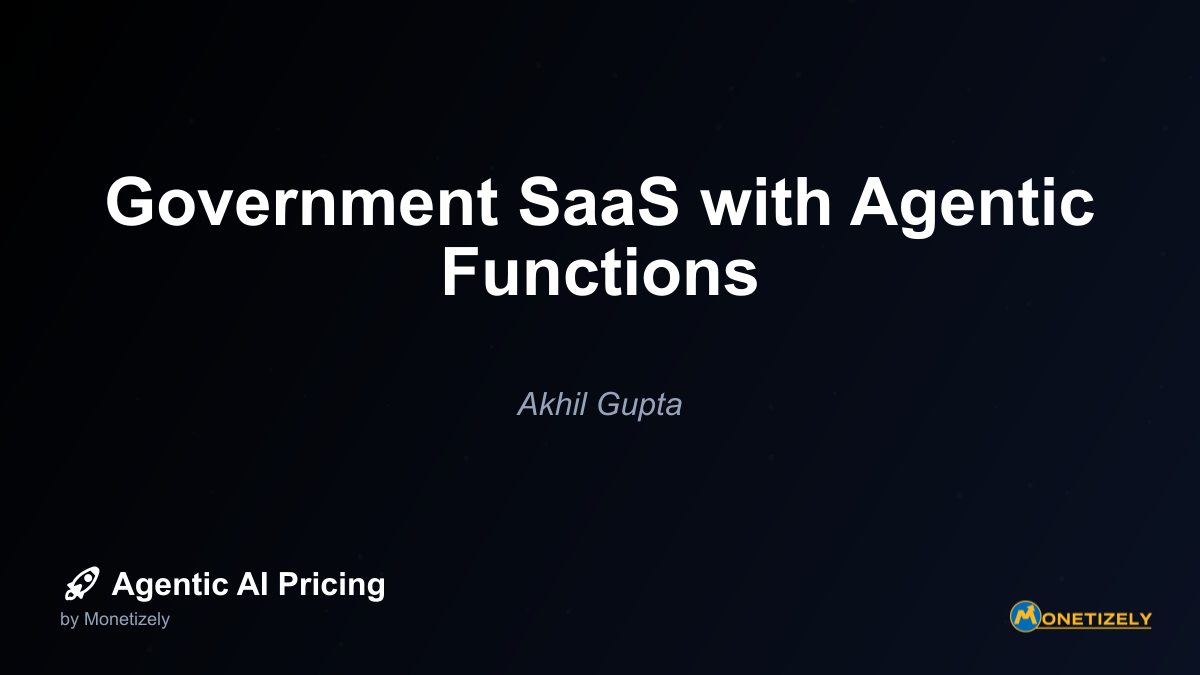
The public sector’s digital transformation journey has accelerated dramatically with the emergence of agentic AI functions in government Software-as-a-Service (SaaS) applications. These autonomous modules are revolutionizing how government agencies deliver services, manage operations, and interact with citizens. Unlike traditional automation tools, agentic AI systems operate with greater autonomy and intelligence, making them particularly valuable for addressing the complex challenges facing modern government organizations.
The Evolution of Government SaaS with Agentic Functions
Government agencies worldwide are increasingly adopting SaaS solutions enhanced with agentic AI capabilities. This shift represents more than a technological upgrade—it’s a fundamental reimagining of public service delivery. Agentic AI goes beyond simple automation by incorporating goal-oriented behavior, contextual awareness, and adaptive decision-making capabilities.
The federal cloud market is experiencing substantial growth, projected to reach $30.3 billion by FY 2028, with SaaS adoption particularly strong among small businesses. Their share of federal cloud spending has grown from 5% in FY 2021 to nearly 21% in FY 2023. This growth is largely driven by mandates for cloud migration, zero trust security implementation, and AI integration across government operations.
Concurrently, the global SaaS market is expanding rapidly, expected to reach $300 billion by 2025 with a compound annual growth rate exceeding 20%. Approximately 50% of SaaS companies are projected to integrate AI capabilities by 2025, powering autonomous modules and personalized automation that can transform government operations.
Key Applications of Agentic AI in Government SaaS
Government SaaS platforms with agentic AI functions are being deployed across various domains, delivering significant improvements in efficiency, accuracy, and service quality.
Citizen Service Delivery
Agentic AI is transforming citizen interactions through:
- Intelligent Case Management: Autonomous systems that process applications, assess eligibility for government programs, and recommend decisions based on complex policy rules
- Conversational Interfaces: Advanced chatbots and virtual assistants that handle citizen inquiries with contextual awareness and the ability to navigate complex government services
- Form Completion Assistance: AI agents that guide citizens through complex government forms, reducing errors and improving submission rates
Regulatory Compliance and Oversight
Government agencies face enormous regulatory burdens that agentic AI can help address:
- Automated Compliance Monitoring: AI systems that continuously monitor operations for regulatory compliance, flagging potential issues before they become problems
- Policy Implementation: Agents that interpret new regulations and update workflows automatically to ensure consistent implementation
- Fraud Detection: Advanced pattern recognition capabilities that identify suspicious activities in financial transactions, benefit claims, and procurement processes
Emergency Response and Crisis Management
When disasters strike, agentic AI provides critical support:
- Coordinated Response: Systems that aggregate data from multiple sources, prioritize resources, and coordinate multi-agency responses
- Predictive Analytics: AI agents that forecast potential crisis developments and recommend preventive measures
- Resource Allocation: Intelligent systems that optimize the distribution of emergency resources based on real-time needs assessment
Technical Implementation Challenges and Solutions
Implementing agentic AI in government SaaS environments presents unique technical challenges that require thoughtful solutions.
Legacy System Integration
Government agencies often operate with complex ecosystems of legacy systems built on outdated technologies. Integrating modern agentic AI functions with these systems requires specialized approaches:
Challenge: Heterogeneous and outdated legacy systems with diverse data standards and disconnected tools create enormous complexity.
Solution: Agentic orchestration platforms that support dynamic, adaptive workflows with guardrails, audit logs, and human-in-the-loop controls allow AI agents to operate with real-time policy enforcement and fallback mechanisms.
Implementation Strategy: Starting with small, high-impact use cases and incrementally integrating AI into existing workflows can reduce workflow integration anxiety and build trust among stakeholders.
The key to successful integration lies in creating flexible middleware layers that can translate between legacy data formats and modern AI requirements. This approach allows agencies to preserve their investments in existing systems while gradually incorporating advanced AI capabilities.
Data Quality and Governance
Agentic AI systems are only as good as the data they operate on. Government data presents particular challenges:
Challenge: Government data is often siloed, inconsistent, and of varying quality, which can compromise AI performance and decision-making.
Solution: Implementing robust data governance frameworks that address data quality, privacy, and regulatory compliance is essential for agentic AI success.
Implementation Strategy: Establishing data quality pipelines that clean, normalize, and validate information before it reaches AI systems helps ensure reliable operation.
Agencies must prioritize trusted, resilient, and error-free data pipelines to ensure AI accuracy and avoid operational disruptions. This requires investments in data management infrastructure and processes designed specifically for AI applications.
Scalability and Performance
Government services must be able to handle varying workloads while maintaining consistent performance:
Challenge: Public sector AI applications often face unpredictable demand spikes, particularly during crisis situations or regulatory deadlines.
Solution: Cloud-native architectures that can scale dynamically in response to changing demands provide the flexibility needed for government operations.
Implementation Strategy: Implementing containerized microservices architectures allows specific AI functions to scale independently based on demand.
Modern SaaS platforms designed for government use must incorporate elastic computing resources and efficient resource allocation to maintain performance under varying conditions.
Security and Compliance Requirements
Security and compliance considerations are paramount in government SaaS implementations, particularly when agentic AI is involved.
Data Security Framework
Government agencies handle highly sensitive information that requires comprehensive protection:
Multi-layered Security: Government AI SaaS must implement security at every level—from the code base to data handling and employee awareness.
Zero Trust Architecture: Implementing zero trust principles ensures that every access request is fully authenticated, authorized, and encrypted.
Continuous Monitoring: Automated security monitoring systems that detect and respond to potential threats in real-time are essential for protecting government data.
The federal government’s FedRAMP (Federal Risk and Authorization Management Program) certification is typically required for SaaS providers serving federal agencies, with many state and local governments adopting similar standards.
Privacy Protection
Citizen privacy is a critical concern that shapes government AI implementations:
Privacy by Design: Incorporating privacy protections from the earliest stages of system design, including data minimization, anonymization, and purpose limitation.
Consent Management: Implementing robust systems for obtaining, tracking, and honoring citizen consent for data use.
Transparency: Providing clear explanations of how AI systems use personal data and ensuring citizens can access and correct their information.
Government SaaS providers must navigate a complex landscape of privacy regulations, including general requirements like GDPR and sector-specific rules for healthcare, financial, and educational data.
Audit and Accountability
Government AI systems must maintain comprehensive records of their operations:
Audit Trails: Detailed, tamper-proof logs of all system actions and decisions provide accountability and support investigations.
Explainability: AI systems must be able to explain their decisions in human-understandable terms, particularly for consequential actions.
Responsibility Models: Clear delineation of responsibilities between SaaS providers and government agencies ensures proper oversight.
The shared responsibility model between SaaS providers and government agencies is particularly important, with agencies retaining control over necessary security controls and compliance enforcement while vendors provide secure infrastructure and features.
Pricing Models for Government SaaS with Agentic AI
Pricing government SaaS solutions with agentic AI functions requires specialized approaches that align with public sector budgeting, procurement processes, and value expectations.
Common Pricing Structures
Government SaaS pricing models typically reflect the unique needs and constraints of public sector organizations:
Enterprise Agreement Model: These agreements cover all users in a department or agency, with clear expansion terms and 3-5 year commitment horizons that align with government budgeting cycles.
Value-Based Pricing: For citizen-facing applications, fees based on population served or transactions processed align pricing with government KPIs and service delivery metrics.
Tiered Pricing with Compliance Features: Basic to premium tiers providing core functions that progress to advanced compliance and automated reporting tools, reflecting the regulatory importance to government agencies.
Fixed Multi-Year Agreements: Over 80% of agencies prefer fixed multi-year commitments that provide budget predictability and simplify procurement processes.
These models provide the predictability and transparency that government procurement processes require while allowing SaaS providers to recoup their investments in specialized government features.
AI Component Pricing Considerations
The inclusion of agentic AI capabilities introduces additional pricing considerations:
Usage-Based Components: AI functions often incorporate usage-based elements (API calls, compute usage) to align pricing with actual consumption and delivered outcomes.
Outcome-Driven Metrics: Linking charges to measurable outcomes such as improved citizen services, reduced manual compliance workload, or transaction volume resonates with government performance goals.
Hybrid Models: Combining base subscription fees with variable AI usage components provides both predictability and flexibility for government customers.
AI-native vendors often implement metered billing approaches that accurately reflect the variable infrastructure costs associated with AI workloads while providing transparency to government customers.
Budget and Procurement Alignment
Government budget cycles and procurement processes significantly influence pricing strategies:
Budget Timing: Many government purchases occur at fiscal year-end, requiring flexible pricing and contracting options to accommodate this pattern.
Procurement Vehicles: Structuring pricing to align with established contract vehicles (e.g., GSA schedule) streamlines the acquisition process.
TCO Transparency: Providing clear total cost of ownership projections and ROI analyses that specifically address compliance burden reduction improves procurement acceptance.
Successful vendors design pricing models that accommodate these constraints while delivering fair value to both the government customer and the SaaS provider.
Change Management and Workforce Adaptation
The introduction of agentic AI in government SaaS requires thoughtful change management and workforce development strategies.
Organizational Change Strategies
Effective adoption requires organizational readiness and support:
Executive Sponsorship: Strong leadership commitment helps overcome resistance and ensures resources for successful implementation.
Phased Implementation: Gradual rollout of AI capabilities allows organizations to adapt processes and build confidence incrementally.
Success Metrics: Establishing clear performance indicators helps demonstrate value and build support for continued adoption.
Change management approaches must address both the technical and cultural dimensions of AI adoption in government settings.
Workforce Development
Government employees need new skills to effectively work alongside agentic AI systems:
Training Programs: Comprehensive training that covers both technical operation and strategic utilization of AI capabilities.
Role Evolution: Redefining job roles to emphasize human judgment, oversight, and exception handling while AI handles routine tasks.
Collaboration Models: Developing effective human-AI collaboration frameworks that leverage the strengths of both.
Successful implementation reallocates human efforts from routine data gathering to high-value decision-making, improving productivity and job satisfaction while addressing concerns about job displacement.
Addressing Resistance
Resistance to AI adoption in government settings must be addressed proactively:
Transparency: Clearly communicating the capabilities, limitations, and oversight mechanisms for AI systems builds trust.
Early Wins: Demonstrating tangible benefits in non-controversial areas helps build momentum for broader adoption.
Stakeholder Involvement: Including frontline workers in design and implementation ensures systems address real operational needs.
Starting with accessible tasks and addressing misinformation about AI capabilities helps build confidence and ease the transition to more advanced applications.
Case Studies: Government SaaS with Agentic AI in Action
Examining successful implementations provides valuable insights into effective approaches and potential benefits.
Singapore’s Government AI Initiative
Singapore has emerged as a leader in government AI adoption:
Implementation Approach: Singapore combined intelligent workflows with strong trust frameworks emphasizing security and transparency.
Governance Structure: A centralized AI governance structure provides consistent oversight while enabling innovation.
Results: Improved service delivery, reduced processing times, and enhanced citizen satisfaction demonstrate the value of their approach.
Singapore’s experience highlights the importance of protecting public trust through accountable, transparent AI systems that deliver measurable improvements in government services.
US Federal Agency Claims Processing
A major US federal agency implemented agentic AI to transform benefits processing:
Challenge: Manual claims processing created backlogs, inconsistent decisions, and high administrative costs.
Solution: Agentic AI systems that assess eligibility, apply policy rules, and recommend decisions while maintaining human oversight for complex cases.
Outcomes: 60% reduction in processing time, 40% decrease in administrative costs, and improved consistency in decision-making.
This implementation demonstrates how agentic AI can address core operational challenges while improving both efficiency and service quality.
European Municipal Services Platform
A consortium of European municipalities deployed a shared SaaS platform with agentic AI capabilities:
Approach: Standardized core services enhanced with AI modules that could be customized for local requirements.
Key Features: Multilingual citizen interfaces, automated permit processing, and intelligent resource allocation across municipal services.
Benefits: Cost sharing across municipalities, consistent service quality, and ability to rapidly implement new regulatory requirements.
This collaborative approach demonstrates how smaller government entities can leverage shared SaaS platforms to access advanced AI capabilities that would be unaffordable individually.
Measuring Success: KPIs and ROI
Evaluating the impact of agentic AI in government SaaS requires appropriate metrics and evaluation frameworks.
Key Performance Indicators
Effective measurement goes beyond basic efficiency metrics:
Operational Metrics: Processing time, case throughput, error rates, and compliance violations provide baseline performance measures.
Service Quality: Citizen satisfaction, first-contact resolution rates, and service accessibility demonstrate impact on government’s core mission.
Employee Experience: Staff productivity, job satisfaction, and skill development track the human dimension of AI implementation.
Adaptability: System responsiveness to policy changes, crisis situations, and evolving citizen needs measures long-term value.
Comprehensive measurement frameworks capture both immediate operational improvements and strategic benefits that develop over time.
Return on Investment Calculation
Government ROI calculations must consider a broad range of factors:
Direct Cost Savings: Reduced staffing requirements, lower error correction costs, and decreased processing expenses provide measurable financial returns.
Opportunity Costs: Value of redirected staff time, faster service delivery, and improved decision quality contributes to overall return.
Risk Reduction: Decreased compliance violations, reduced fraud, and improved security posture represent significant value.
Social Impact: Improved citizen access to services, better outcomes for vulnerable populations, and enhanced public trust deliver mission-critical returns.
Government ROI frameworks must balance quantitative financial measures with qualitative assessment of mission fulfillment and public benefit.
Continuous Improvement
Measurement should support ongoing optimization:
Feedback Loops: Systematic collection and analysis of performance data drives continuous improvement.
A/B Testing: Controlled experiments with alternative approaches identify optimal configurations.
Adaptive Systems: AI capabilities that learn from experience and improve performance over time deliver increasing returns.
Effective measurement frameworks evolve alongside the systems they evaluate, incorporating new metrics as capabilities and expectations advance.
Vendor Selection Criteria for Government AI SaaS
Selecting the right SaaS provider for government AI implementation requires careful evaluation across multiple dimensions.
Technical Capabilities
Core technical requirements include:
AI Sophistication: Advanced natural language processing, machine learning, and autonomous decision-making capabilities aligned with agency needs.
Integration Flexibility: Robust APIs and connectors for legacy systems, other SaaS platforms, and government data sources.
Scalability: Ability to handle varying workloads while maintaining performance and security.
Customization: Configuration options that accommodate agency-specific requirements without costly custom development.
Technical evaluation should include hands-on testing with realistic government scenarios and data to verify performance claims.
Security and Compliance Credentials
Government requirements demand stringent security and compliance capabilities:
FedRAMP Authorization: For federal agencies, appropriate FedRAMP authorization level (Low, Moderate, or High) is typically mandatory.
Compliance Framework: Comprehensive security controls aligned with NIST standards and other relevant frameworks.
Privacy Features: Robust data protection, anonymization, and consent management capabilities.
Audit Capabilities: Detailed activity logging, anomaly detection, and forensic investigation tools.
Vendors should demonstrate not only current compliance but also the ability to adapt to evolving security requirements and threat landscapes.
Government Experience
Previous government experience provides valuable insights:
Agency References: Successful implementations at similar agencies indicate understanding of government requirements.
Procurement Knowledge: Familiarity with government contracting vehicles and processes simplifies acquisition.
Policy Expertise: Understanding of relevant regulations and policy frameworks ensures appropriate functionality.
Staffing Requirements: Government security clearances and background checks for vendor personnel who access sensitive systems or data.
Vendors with established government practice areas typically provide more effective support for public sector implementations.
Support and Partnership Approach
Long-term success depends on effective vendor relationships:
Implementation Methodology: Structured approach that accommodates government decision processes and stakeholder engagement.
Training Programs: Comprehensive training tailored to government workforce needs and learning styles.
Ongoing Support: Responsive support with government-specific expertise and appropriate security clearances.
Innovation Roadmap: Clear vision for future capabilities and willingness to incorporate government requirements into product development.
The most successful vendor relationships evolve into true partnerships where both parties contribute to continuous improvement and innovation.
Future Trends in Government AI SaaS
The government SaaS landscape with agentic AI functions continues to evolve rapidly, with several key trends shaping future development.
Technological Advancements
Emerging technologies will enhance government AI capabilities:
- **Agentic Orchestration
Co-Founder & COO
Akhil is an Engineering leader with over 16+ years of experience in building, managing and scaling web-scale, high throughput enterprise applications and teams. He has worked with and led technology teams at FabAlley, BuildSupply and Healthians. He is a graduate from Delhi College of Engineering and UC Berkeley certified CTO.
Pricing Strategy Audit
Let our experts analyze your current pricing strategy and identify opportunities for improvement. Our data-driven assessment will help you unlock untapped revenue potential and optimize your AI pricing approach.

